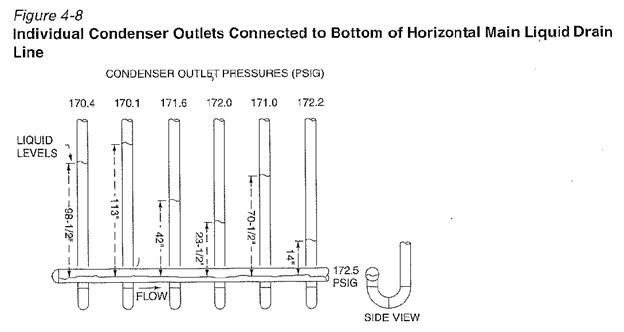Condenser Drop Legs
Last week I had the opportunity to attend a RETA Safety Day. At this meeting I listened to a presentation on purging non-condensables and it reminded me of an important design aspect when designing/installing the piping for ammonia condensers.
The situation I am thinking about primarily concerns installations involving multiple condensers, or at least multiple condenser circuits, piped in parallel. In this situation, it is necessary to trap each circuit outlet, either individually or as a group.
Having each of the circuits trapped allows the system to balance itself to encourage equal flow through all of the circuits. Since the real pressure drop through each circuit is always different, even if only minutely, there needs to be a way to equalize the pressure drop in order to get equal flow. This is done by “backing up” the liquid in the drop leg. The amount of liquid that backs up the drop leg is determined by the actual pressure drop through the circuit.
This diagram from the IIAR 2019 “The Refrigeration Piping Handbook” shows what this might look like.

As you can see, minor differences in pressures can have a significant effect on the height of the liquid backed up in the drop legs. And sometimes it stacks pretty high!
The point that I want to make is that the length of the drop leg is very important. If the drop leg is too short, the liquid will back up into the condenser tube bundle, which will likely cause problems. For sure this reduces the capacity of the condenser, but it could also cause a variety of other problems.
Unfortunately, I have seen many installations out there with drop legs as short as 2 ft, and many, many about 4’ in length. In the case shown in this IIAR diagram you can see that with 4 ft drop legs, 3 of the 6 circuits would have liquid backed up into the condenser tube bundle.
At Carlson & Stewart Refrigeration, we shoot for drop legs that are 10-12 ft in length, whenever possible. There are certainly situations where this is not possible. In these cases, consideration of other design characteristics become even more critical. There is always a solution, you just need to be aware that a solution is needed.
If you have any questions about condenser piping design or on general refrigeration, give us a call here at Carlson & Stewart Refrigeration. We will be happy to help!
